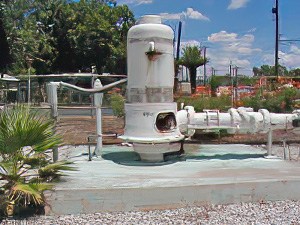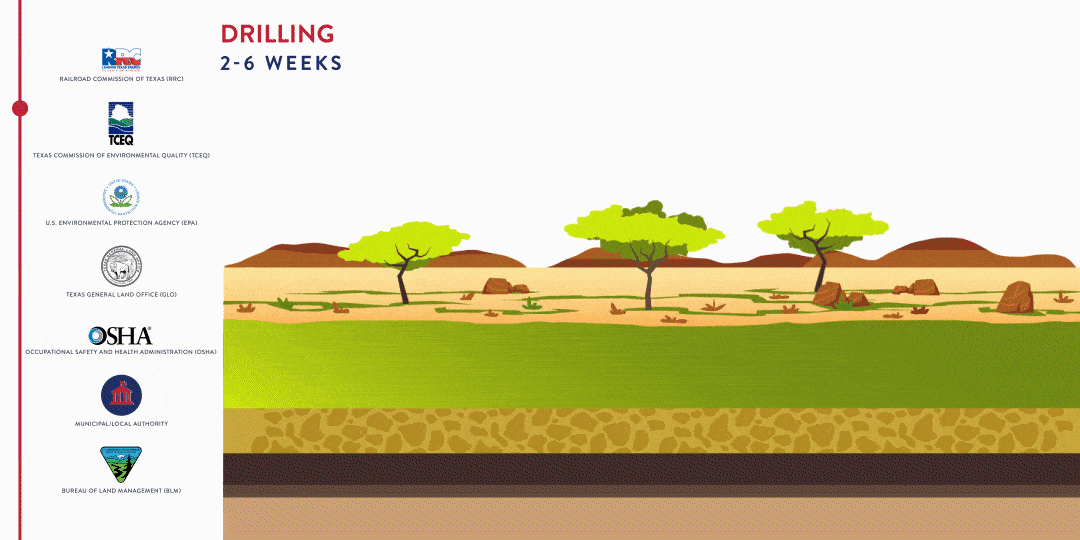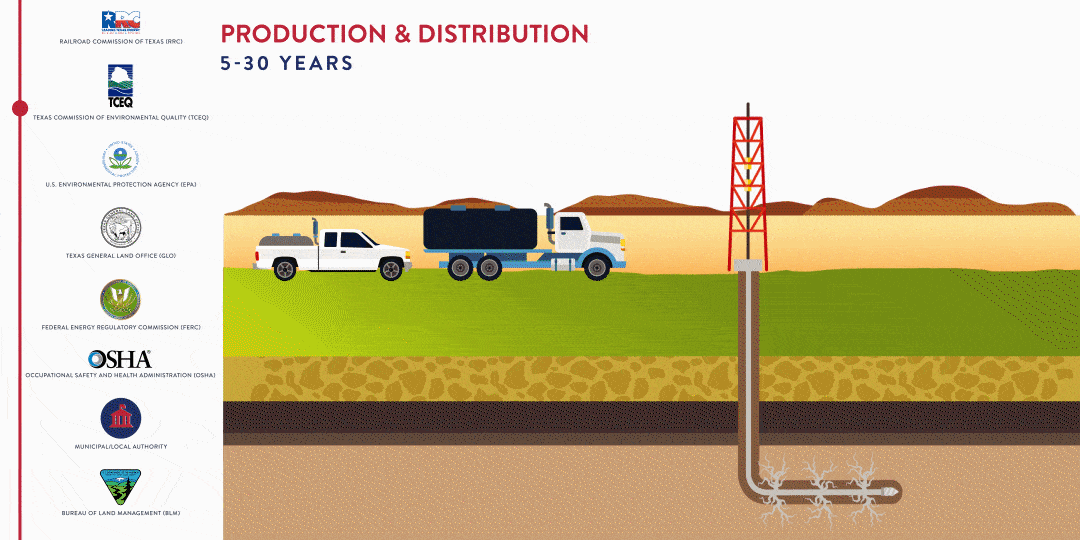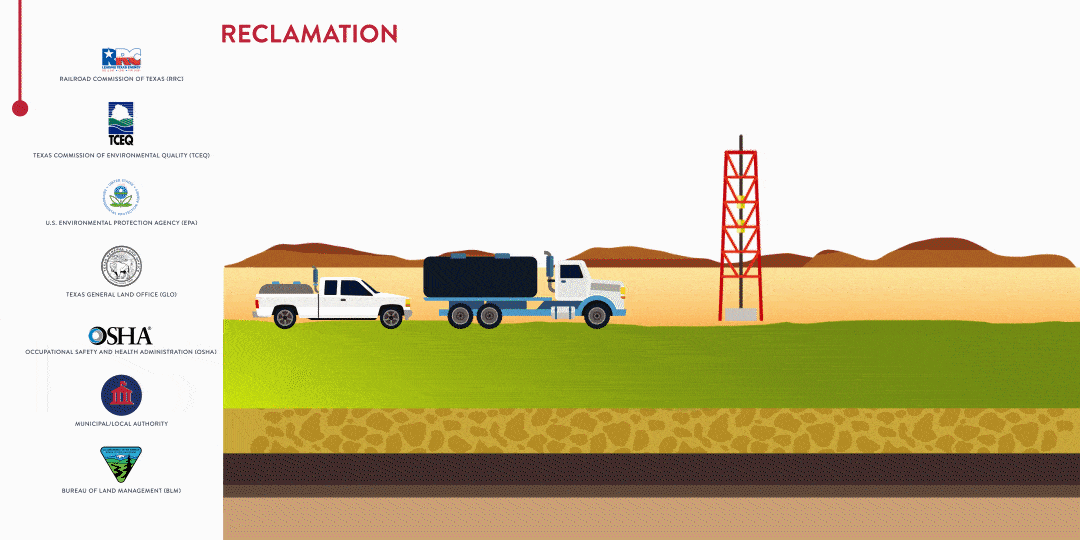No matter its purpose, a well must be drilled anticipating potential problems that could occur and compromise health, safety, and the environment. Contamination is a large concern for design, construction and operation of wells, whether they are for extraction or injection. Prevention is paramount, for health and safety reasons, as well as environmental aspects. Although most wells are drilled without incident, the consequences of a failure can be significant. Later on in this course we review a disastrous accident that occurred as a result of poor well-design and prevention controls.
Regulatory Oversight of Wells
Oversight of Extraction Wells
Extraction wells may be regulated by federal, state, and local entities. As presented earlier, extraction wells may serve as access to water, oil, gas or mineral resources. We will turn our focus towards regulatory oversight of extraction wells later on in this lesson and see that here in Texas, the Railroad Commission of Texas (RRC) is responsible for regulatory oversight of the state’s oil and gas extraction wells.
Oversight of Injection Wells
A number of parties are involved in regulatory oversight of injection wells. Within the United States, the Environmental Protection Agency (EPA) along with other state agencies are the main parties in charge of regulation. The majority of the EPA’s regulatory oversight falls within their federal Underground Injection Control (UIC) Regulations and Safe Drinking Water Act Provisions. We will see shortly that EPA oversight can be delegated to other regulatory entities, such as state regulatory agencies. Regardless of who has responsibility for oversight, these regulatory agencies have a mandate to protect citizens as well as the environment. State agencies will have the added mission to make sure that industrial processes benefiting the state’s residents proceed smoothly.1Environmental Protection Agency. (n.d.). Underground Injection Control Regulations and Safe Drinking Water Act Provisions. U.S. Environmental Protection Agency. Retrieved June 23, 2021, from https://www.epa.gov/uic/underground-injection-control-regulations-and-safe-drinking-water-act-provisions
Environmental Protection Agency
The EPA is the biggest player in well regulation across the country, because they set out the regulation provisions for different classes of injection wells under their federal UIC regulations. The agency has a mandate to protect public health by preventing injection wells from contaminating underground sources of drinking water (USDWs). Currently, the EPA defines six classes of injection wells:
- Class I: Industrial and Municipal Waste Disposal Wells
- Class II: Oil and Gas Related Injection Wells
- Class III: Injection Wells for Solution Mining
- Class IV: Shallow Hazardous and Radioactive Injection Wells
- Class V: Wells for Injection of Non-Hazardous Fluids Into or Above Underground Sources of Drinking Water
- Class VI: Wells Used for Geologic Sequestration of CO2
Primacy
Through a very strict application process with the EPA, some states are given the authority (primacy) to regulate certain classes of UIC wells within their state. For example, North Dakota and Wyoming have primacy over all six classes of UIC wells. In contrast, New York and Pennsylvania have not received primacy to administer the federal UIC program for any of the six classes of wells, and therefore, the EPA administers the program within each state. Colorado only has primacy over Class II UIC wells, and thus the Colorado Oil and Gas Conservation Commission (state agency) regulates Class II wells and the EPA regulates the other five classes of wells. Texas has primacy over the permitting of Class I-V wells, but not Class VI wells (although they are soon applying for primacy over this well class). Primary oversight for Texas UIC wells, as you will see below, is divided between two different agencies.
Regulation of Wells in Texas
Taking a focus on Texas, let’s look at some of the state regulatory agencies and organizations that are involved in the regulation of both extraction and injection wells, from a variety of aspects.
Texas Railroad Commission (RRC)
Regulation of oil and gas extraction and injection wells in the state is reserved for the TRC. The TRC’s responsibilities for extraction wells include permitting, oversight of drilling operations, and inspection of exploration and production wells and facilities. Class II injection wells fall under the jurisdiction of the TRC because Texas has been awarded primacy on their oversight from the EPA.2Railroad Commission. (n.d.). Oil and Gas. Railroad Commission of Texas. Retrieved June 23, 2021, from https://www.rrc.texas.gov/oil-and-gas
Texas Commission on Environmental Quality (TCEQ)
The TCEQ supplies information to consumers regarding water wells, their sources prior to reaching drinking water municipalities, and details regarding their operations (drill date, pumping rate, etc.). The TCEQ also works with well operators to maintain standards and assure that provisions are met for drinking water. Formally named the TCEQ in 2002, this agency can trace its predecessor agencies back to 1913. The state of Texas has assigned permits for Class I, III, IV, and V wells to TCEQ because Texas has been awarded primacy from the EPA.3Texas Commission on Environmental Quality. (n.d.). Flowchart of TCEQ and its Predecessor Agencies. Retrieved June 23, 2021, from https://www.tceq.texas.gov/agency/organization/tceq-flowchart.html4Texas Groundwater Protection Committee. (n.d.). Water Wells. Retrieved June 23, 2021, from https://tgpc.texas.gov/water-wells

Texas Water Development Board (TWDB)
The mission of the TWDB is to lead the state’s efforts in ensuring a secure water future for Texas and its citizens. The agency was created in 1957 after the state experienced the most severe drought in the state’s history. The board’s three main responsibilities are:
- Collect and disseminate water-related data
- Plan for the development of the state’s water resources
- Administer cost-effective financing programs
The TWDB along with the Texas Department of Licensing and Regulation maintain a database of water wells in the state.5Texas Water Development Board. (n.d.). About the Texas Water Development Board. Retrieved June 23, 2021, from http://www.twdb.texas.gov/about/index.asp#twdb-history6Texas Groundwater Protection Committee. (n.d.). Water Wells. Retrieved June 23, 2021, from https://tgpc.texas.gov/water-wells7Texas Water Development Board. (n.d.). Compact with Texans. Retrieved June 23, 2021, from http://www.twdb.texas.gov/home/compact_texan.asp
Regulatory Oversight of Labor Involved in Extraction and Injection Wells
Because many industrial activities, including those involving extraction and injection wells, involve human labor where workers may be exposed to dangers and hazards, the federal government has set up oversight to protect these workers.
Occupational Safety and Health Administration (OSHA), U.S. Dept. of Labor
Congress created OSHA in 1970 to set standards that companies must follow to protect their workers from hazards associated with health, safety, and the environment. Additionally, employees must take OSHA held classes for certification before they can work in hazardous work conditions.8Occupational Safety and Health Administration. (n.d.). About OSHA. U.S. Department of Labor, Occupational Safety and Health Administration. Retrieved June 23, 2021, from https://www.osha.gov/aboutosha9Occupational Safety and Health Administration. (n.d.). Oil and Gas Extraction. U.S. Department of Labor, Occupational Safety and Health Administration. Retrieved June 23, 2021, from https://www.osha.gov/oil-and-gas-extraction



Image Credits
- San-Antonio-Water-Well-EDIT: Alan Cherepon, TCEQ
- 2020_Drilling_2: Photo Courtesy of Texans for Natural Gas
- Frame_4_compress: Photo Courtesy of Texans for Natural Gas
- Frame_5: Photo Courtesy of Texans for Natural Gas